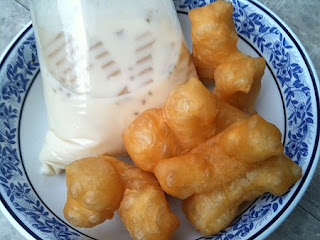Authenticity is perhaps the biggest lightning rod when it comes to fodder amongst hardcore food enthusiasts, especially for those online. It’s an odd criteria, a subjective crystallization of a certain trope of a certain group at a certain locale at a certain time, a tall benchmark that gets zealously applied, particularly when speaking of ethnic restaurants. The best compliment that any ethnic restaurant can receive? It was authentic.
Such was the online discussion about I Likes Thai Food, a relatively new restaurant on the Main Street of a city already littered with Thai-ish restaurants. Discussion boards, blogs, etcetera were all raving about the restaurant, emphatic about its authenticity, despite the fact that many of those opining have likely never been to Thailand for longer than that rite-of-passage backpack trip, if at all.
The key or at least starting factor in this judgment seems to be based on ketchup. Many Thai places around town use an abundant quantity of the condiment when making their pad thai: of course, no such use occurs in Thailand, or so I’ve been told. In fact, out of the sheer number of Thai restaurants in town, there are surprisingly few of them that don’t use ketchup, and so the pad thai/ketchup criteria has seemingly developed as a determinative criteria (particularly amongst those on Chowhound) as to whether a restaurant is authentic enough to be worthy of a visit.
No, I Likes Thai Food does not use ketchup in their pad thai ($12). Instead, their version is tangy with tamarind and fish sauce, and made with the standard bean sprouts, egg, tofu, and prawns, dusted with peanuts. Pad thai, I suppose, is one of those dishes where “more” is not more, and many places go horribly awry when the urge to add gets out of hand.

As one would surmise, there are many curries on hand as well, which you can eat in their loosely decorated room where reggae is king and the atmosphere akin to a Main Street living room (albeit cleaner and brighter, though just as conservative with luxuries). The green chicken curry ($10.50) is a dense layering of flavour upon flavour, indebted to lemongrass and wed to coconut milk. A roasted red duck curry ($13, not on the regular menu) is not nearly as spicy as the waitress had warned (she had already been back to the kitchen to report numerous complaints, which I suspect led to the anticlimax), and balanced out with pineapple and lychee. Neither curry were particularly generous with the protein, another slight disappointment that one must overlook.

What can’t be overlooked, however, is the mess that is the Swimming Rama ($9.50). The dish’s name is derived from the Hindu deity Rama, an avatar of Vishnu, who, in some depictions of Rama’s battle with the demon god Ravana, has a green body, which is represented by the leafy vegetables in the dish (at Bob Likes Thai Food, spinach). This then ‘swims’ in the peanut sauce and protein (at Bob Likes Thai Food, tofu), or drowned, in this version. A more sturdy vegetable than spinach would have had more of a fighting chance, but the limp spinach really needed a miracle to save it from sacrilege.

Salads fare a bit better. The green papaya salad ($6.50) is fresh and crunchy, heavily dressed and sweet, though with an ambitious amount of spice. The laab moo ($10), a salad originating from the Isaan region in northeastern Thailand, mixes ground pork, well-flavored with lime and chili, with not-quite-enough toasted rice: contrasts in flavour without a contrast in texture. Both, though, are worthy introductions to the restaurant.
At the other end of the meal, you’ll need to ask your server about dessert before they proffer. They don’t appear on the menu, and, at times, aren’t necessarily pronounceable by the non-Thai staff. Tai, the proprietor, came out to offer us Ka Nom Tom, traditional sticky rice flour dumplings coated with shredded coconut and with even more coconut in its centre, a delight to think about and even better to eat. The desserts don’t seem to be made on site, so expect the options to vary.
To be upfront honest about it, I’ve never been to Thailand, though I have eaten at many Thai restaurants. I’ve never been to the Mississippi Delta, though I have listened to enough blues records. I’ve never been in a Hong Kong triad, though I’ve watched a fair share of Johnnie To films. Point is, all of these things have given me a glimpse of someone’s view of a certain place and a time, and I measure their success in terms of how vivid that glimpse or depiction is. And though I’ve never run boats off Koh Samui or dodged scooters on the streets of Bangkok, the food at Bob Likes Thai Food gives a certain snapshot of it, and, authentic or not, it’s a lively one. And that, much more than authenticity, seems like a worthy criteria.






















